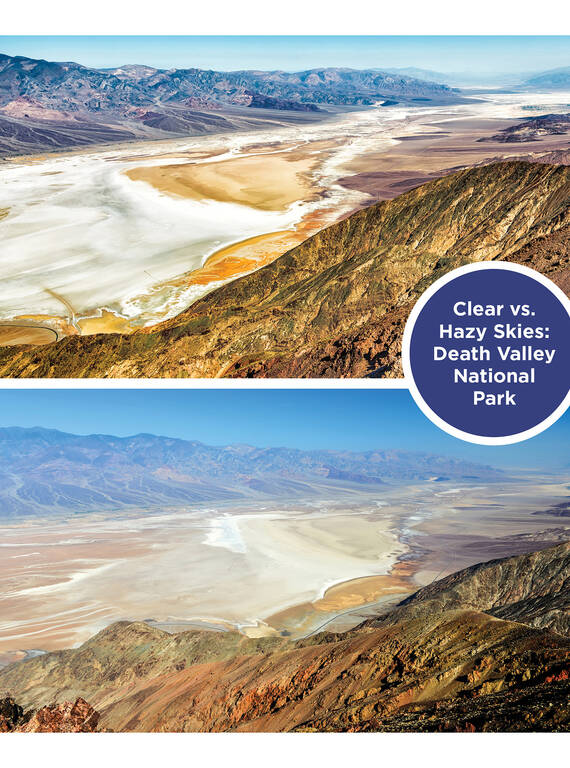NPCA has released its 2024 “Polluted Parks” report, showing 97% of national parks suffer from air pollution. Meanwhile, the Environmental Protection Agency recently strengthened its air quality standards, which will provide additional protection to these places we love.
Here are the latest developments and what they mean.
Why is air pollution an issue in national parks?
Air pollution is among the most serious threats to our national parks and monuments. Whether generated by industrial facilities near a park boundary or traveling from afar via air currents, dirty air ruins scenic views, harms wildlife and historic sites, and affects the health of visitors.
Ozone is one of the most widespread pollutants in parks, and it’s caused when naturally occurring volatile organic compounds react in sunlight with pollution from cars and industries. Ozone makes it harder for people and wildlife to breathe because it inflames and irritates the lungs. Those with asthma or other respiratory illnesses are especially at risk. Ozone pollution also stifles the growth of trees and plants.
What is NPCA’s “Polluted Parks” report, and what does it reveal?
A follow-up to NPCA’s 2019 assessment, 2024’s “Polluted Parks: How Air Pollution and Climate Change Continue to Harm America’s National Parks” is an air pollution and climate threats report prepared and released by NPCA based on data provided by the National Park Service. It shows that 97% of U.S. national parks suffer from significant or unsatisfactory levels of harm from air pollution in at least one of the report’s categories. Specifically, 98% of parks suffer from concerning levels of haze pollution, obscuring scenic views and landmarks; 96% face ozone pollution that negatively affects human health for staff, visitors and communities which live nearby; and 96% have sensitive species and natural habitats harmed by pollution.

Polluted Parks
National parks are home to some of America’s most iconic landscapes and best-preserved cultural and historic sites, and these places need clean air and a healthy climate to flourish. Yet…
See more ›The report found that air pollution permeates nearly all national parks across the United States, from Hawaii’s iconic volcanoes to Kentucky’s Mammoth Cave. Coast to coast, Americans experience muddied views and skies choked with dirty air that harms people’s health and nature in and around national parks.
We know air pollution drives the climate crisis, and NPCA’s latest report additionally shows that while all parks struggle with various effects of a rapidly changing climate, 57% of parks face heightened threats from four serious consequences of climate change: wildfire, drought, sea level rise and invasive species. Our parks are, in many cases, on the frontlines of the climate crisis.
What is NPCA doing to clean up air in national parks?
For years, NPCA has taken the lead in curbing pollution at its source to address not only risks to air quality, but the various climate risks found in the report. We work for clean air and a healthy climate for national parks and all people by strengthening clean air and climate laws and regulations, putting people first in our advocacy to hold polluters accountable, and engaging park advocates.
In fact, NPCA’s leadership has resulted in the reduction of 1.4 million tons of visibility-impairing pollution reduced, the closure of cleanup of over 150 park-polluting coal plants and the elimination of 171 million metric tons of climate pollution.
Our advocacy efforts involve a combination of raising awareness, working to hold states accountable for their industrial facilities that causes haze pollution, advocating for strong national air standards to protect parks and nature, and emphasizing the importance of stronger climate science. NPCA also advocates for funding so the National Park Service and Environmental Protection Agency can continue monitoring air pollution and updating their instrumentation, and we alert decisionmakers of environmental damage and apply pressure to the EPA.
In what way did the EPA recently upgrade air quality standards?
On Feb. 7, the EPA announced an updated primary national air quality standard under the Clean Air Act, which provides protections for all people against fine particulate matter, known as PM2.5. Particulate matter pollution comes from heavy duty trucks and vehicles, as well as industrial facilities such as coal plants. This air pollutant is known to harm human health and creates the haze that ruins scenic views.
However, EPA failed to update what it calls secondary standards, missing an opportunity to extend protections beyond human health to park visibility, animals and crops. Still, the strengthened primary annual standard serves as a big step in recognizing the harmful effects of PM2.5 and acknowledges years of efforts from NPCA and our partner, the Appalachian Mountain Club. Together, our organizations have steadfastly advocated for ecosystems and national park health in EPA’s consideration of stronger standards to protect scenic views, sensitive ecosystems and nature.
What will the strengthened air quality standards mean for national parks?

A graphic from the 2024 “Polluted Parks” report, using a clear view from Death Valley National Park’s Dante’s Point (credit: ©Federico Franzone | Dreamstime) and the same viewpoint obscured by haze pollution (credit: ©Demerzel 21 | Dreamstime).
© NPCAThese stronger standards will provide additional clean air protection for national parks across the country — from Sequoia and Kings Canyon in California to Gateway Arch and Mammoth Cave national parks in Missouri and Kentucky.
These places and many others suffer from excessively hazy skies.
Ulla Reeves, interim director of NPCA’s Clean Air Program, said, “People who travel thousands of miles to behold these national treasures should not bear risks to their health resulting from air pollution. We look forward to working with EPA to ensure this rule benefits parks and people far and wide, so that all can enjoy stunning vistas, clean air and cultural resources for generations to come.”
Does pollution affect parks equally?
No, pollution affects parks in different ways. The latest “Polluted Parks” report includes five case studies to highlight the assorted challenges and the diverse air and climate issues faced by parks in various geographic locations. The case studies also reflect how NPCA is working to improve those specific conditions, particularly with regional haze.
For example, in Everglades National Park at the southernmost tip of Florida, the average natural visual range should span about 100 miles without pollution, but the actual typical visual range is about 40 miles. It can dip as low as 20 miles on high pollution days because of contaminants in the air — which can come from nearby agricultural burning and industrial facilities, or polluters hundreds of miles away.
Mammoth Cave National Park in Kentucky has unsatisfactory levels of hazy skies and unhealthy air — not just above ground, but underground, too — from nearby coal-fired power plants and industry. Airborne contaminants find their way into the cave system, affecting delicate geologic formations and influencing the subterranean ecosystems that have remained preserved for thousands of years. The park experiences significant concern levels in the Polluted Park report’s “Harm to Nature” category, mainly due to nitrogen and sulfur deposited in soil and water.
California’s Sequoia and Kings Canyon National Parks are among the most polluted, with poor visibility and dirty air a regular occurrence of significant concern. This is a direct result of pollution from industrial sources such as oil and gas, agricultural operations, and cars and trucks throughout the state. The parks are also vulnerable to increased drought and wildfire due to climate change.
What has NPCA been doing to curb pollution at Everglades, Mammoth Cave and Sequoia and Kings Canyon?
Among our efforts in Florida, NPCA and its partners are advocating for EPA to hold the state accountable to cut haze emissions. We also lead advocacy efforts in support of the Western Everglades Restoration Plan, which — if authorized by Congress — would improve connectivity in this ecosystem and could lead to fewer, less severe wildfires.
In Kentucky, we have consistently asked the state to develop a strong plan to reduce haze pollution. We also continue urging the EPA to hold Kentucky accountable and strengthen national clean air standards to protect the park’s ecological integrity both on the surface and underground.
In California, NPCA has worked with a large coalition of environmental and public health groups to clean up some of the nation’s dirtiest air in the San Joaquin Valley to help benefit local communities and adjacent national parks. We have helped oversee local planning and enforcement of the Clean Air Act to seek reductions in fine particulate matter and ozone pollution from cars, trucks, and oil and gas operations. Our 2018 court victory held state agencies accountable for air pollution regulation throughout the state that will also benefit Yosemite, Sequoia and Kings Canyon.
Are parks better off or worse than they were in 2019?
While the 2019 and 2024 reports were conducted in slightly different ways and analyzed different number of parks (417 in 2019 versus 399 this year), there have been notable improvements in some of the reports’ categories.
For example, the 2024 report shows a considerable reduction in the number of parks exhibiting significant concern levels in the “Hazy Skies” and “Unhealthy Air” categories. However, there has been a decline in the health of parks in the “Harm to Nature” category — specifically from ozone damage and pollution such as nitrogen and sulfur that is deposited into soil and water.
The key air quality findings in 2019 were that 85% of U.S. national parks had air that was unhealthy to breathe at times, 88% had air pollution that was harmful to nature and 89% suffered from haze pollution. This year’s report findings are that 98% of the 399 national parks NPCA assessed suffer from haze pollution, 96% face ozone pollution that negatively affects human health for staff, visitors and nearby communities and 96% of parks have sensitive species and natural habitats harmed by pollution. While these figures represent higher percentages compared to the previous report, it’s important to acknowledge that the number of parks assessed was slightly different.
In 2019, climate change was a significant concern in 80% of national parks. The updated analysis, which is a very different set of data than before (looking specifically at high risk climate threats for parks), finds that 57% of parks face heightened threats from four specific consequences of climate change.
What more needs to be done?
To protect the places we love, we need continued action from federal and state agencies to cut air pollution through time-tested, effective programs such as the Regional Haze Rule — which is mandated by the Clean Air Act but is not being effectively implemented by most states.

Fishing is a common activity in many national parks.
© Feverpitched | Dreamstime.comAdditionally, the strengthening of national air standards and the haze rule, improvement of air monitoring in and near national parks, and the advancement of climate-friendly policies are critical to the future of our public lands.
The progress we’ve made so far could not have been possible without engaged citizens who lift their voices for the protection of national parks. We are grateful for the work of NPCA’s members and supporters!
We encourage everyone to stay involved by subscribing to NPCA emails, texts and action alerts and lending your voice to our initiatives through NPCA’s Our Advocacy webpage.
Stay On Top of News
Our email newsletter shares the latest on parks.
About the authors
-
 Lam Ho Former Senior Climate Communications Manager
Lam Ho Former Senior Climate Communications ManagerDuring her time as NPCA’s Senior Climate Communications Manager, Lam called attention to the effects of climate change on public lands with an emphasis on air quality and environmental justice.
-
 Linda Coutant Staff Writer
Linda Coutant Staff WriterAs staff writer on the Communications team, Linda Coutant manages the Park Advocate blog and coordinates the monthly Park Notes e-newsletter distributed to NPCA’s members and supporters. She lives in Western North Carolina.
-
General
-
Issues


